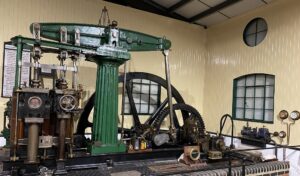The Thomas Horn Beam Engine
A major manufacturer of beam engines was Thomas Horn of Westminster and in 1870 he built and supplied two beam engines of the James Watt design for the Water Company at Ashford, Kent.
These rotative steam engines were decorative as well as utilitarian and had fluted Doric columns and polished steel motion. They each operated a three cylinder pump which lifted water from a well and delivered this to a reservoir from which it was distributed to premises throughout the Ashford area.
The engines worked from 1870 to about 1940, at which time a new pumping house was erected and electrically powered pumps installed. The site on which the engines worked at Henwood was required for other purposes and in 1998 Mid-Kent Water made one engine available to the Bredgar & Wormshill Light Railway which is situated about 25 miles from Henwood
This wonderful example of Victorian engineering has been restored at Bredgar and has been erected in a way which resembles the original installation, insofar as this is possible. The pumps are about three metres below ground level, as they were originally and the engine drives the pumps through a mechanism which can be closely observed. The steam is supplied from a modern boiler in an adjacent building.

Ennstalbahn- A Wonderland In G Scale
This is a G Scale Model Railway which attracts the interest of all ages. It has been constructed with LGB track track and runs a selection of LGB locomotives and rolling stock.
As all railway modelers know a model railway hardly ever gets finished, scenery can take forever and there is always some little item that can be added. Construction of the scenic framework and track-bed commenced at the end of August 2001 and the layout went into operation in its basic form at the first public open day of the following year. All went well, and the trains all preformed as expected. There were very few disasters, just a couple of derailments due to excited little fingers and one young lad who decided to wash his hands is the river. All in all it was well received and has become a worthy attraction.
After making the basic railway operational we carried out a continual program of improvements, with the addition of buildings, a mountain section with cable car and hot air balloon. A large extension was added during the winter period 2005/6 allowing for additions of a rack railway, tramway, a funicular and wood yard. Look out for many novel features. See how many you can find. Talk to our friendly operators and find out if you spotted them all.
Fellow railway modelers are welcome to spend a while chatting to our modelers who will be only too pleased to tell you all about the on going construction of this fantastic model.
Marshal Portable
This 8nph portable engine was built in 1912 – works number 57121. Purchased new by Williamson Balfour Valparaiso, Santiago Concepcion Valdivia, Chile. They were believed to be the sole agents in South America. We think is was sold to and worked on a ranch in Argentina. It was found in a scrap yard in Argentina along with many others and imported back to the UK in around 2015. It was donated to BWLR in 2019. It requires a lot of work and which is being undertaken as time allows.
Dutch Street Organ
The Railway’s 56-key Dutch street organ.
Twin Furnace Boiler Front
The front plate for a twin furnace coal fired boiler used at a water pumping station in Ramsgate, Kent. As can be seen from the casting around one of the firebox doors it was made in 1889 by W.& J. GALLOWAY & SONS of MANCHESTER, – boiler No. 7419.
The Pooley Weighbridge
This item was donated to the BWLR by Jewson Ltd., Maidstone. This firm have taken over a building that was once part of the Tilling Stevens complex in St. Peter Street, Maidstone, Kent and their yard backs unto the Barracks Railway Station. Pooley weighbridges were an everyday sight at Railway stations the length and breadth of the UK and at first it was thought that this weighbridge came from the Barracks Station but some investigation reveals that it was probably used in the Old Tilling Stevens’ building. The large plate being fitted in the floor of the building at the entrance, the scale was found in a corner close by this entrance.
Swiss Station Bell
This genuine Swiss Station Bell which was kindly donated to the Railway has been installed next to Warren Wood Station. Such station bells were common all over Switzerland’s rail network, on the national, the private and even the narrow gauge lines. They were gradually replaced by simpler and smaller all electric units. The bells were an audible announcement for approaching trains which triggered an electric contact in the rail track. The forthcoming arrival from the different approach directions was indicated to the railway’s staff (and the knowing clientele) by a designated bell, each with an individual ringtone. One tone, two tone and even three tone bells were used. The clock work mechanism is driven by a counter weight within the tubular stand of the bell. It has to be wound up manually by a crank handle (usually once a day). A solenoid within the bell triggers the mechanically programmed ringing sequence.
The Water Flow Meter Clock
This Water Flow Meter Clock came to the BWLR with the Thomas Horne beam engine from Henwood Pumping Station at Ashford in Kent and it was considered to be unserviceable. It was made by George Kent of Luton [Patentees: Clemens Herschel & Builders Iron Foundry USA].
